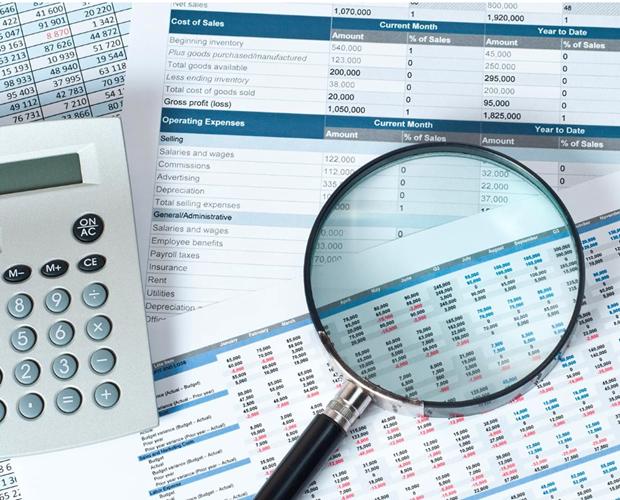This article will focus on filling out a report on the financial results of the company.
Enterprises focus their activities on the production of specific goods and services, which are then sold on the market. To make this possible, an enterprise needs appropriate assets and capital, for example, machines or devices and means, which can be used to finance their purchase.
The report on the financial results of the company, together with the balance sheet, is an important component of the financial statements. It belongs to the category of mandatory, which means that organizations that prepare financial statements must also collect this type of documents.
Concept
The report on financial results is an important addition to the information presented in the balance sheet, which is a kind of photograph of the state of the company. Namely, the profit and loss account shows and records how the financial result is created during the functioning of the business. This is a statement of revenue and expenses incurred by the company for the year. It allows you to determine the effectiveness of the business at certain levels of its activity.
The report covers the time interval, which is usually the financial year when the entity prepares the annual financial statements. Obviously, a report on financial results covering a different period, such as a quarter, can be prepared for the internal needs of the organization.
The result of the activity of the enterprise is the generation of income and the formation of net profit, that is, the excess of income over the costs incurred. These results are reflected in the study report. The analytical conclusions about the financial condition of the company, as well as its forecasts for the future, depend on the correctness of its compilation. Therefore, the questions of filling out a report on financial results are very relevant for most enterprises in modern conditions.

Key Report Elements
When considering the issue of filling out a report on financial results, we will study its main elements.
Analyzing this form, we can distinguish elements that include various constituent components, the information content of which relates to various operations of the organization. Namely, they can be conditionally divided:
- basic operations;
- other operations;
- financial operations;
- final financial result.
In accordance with the highlighted elements, they adhere to the procedure for filling out a report on financial results.
Let us explain that some paragraphs of the report very often characterize the level of basic and other operations as a single, more general category - operational activities. Then it is divided into two components, listed above.
In a situation when they fill out a report on financial results, an important element is the total of the main operations and its formation.
Generation of income from core operations
Basic operations - this is an element of the report on financial results, which is associated with the main operating activities of the enterprise. This means that at this level, revenue is different, and costs, among other things, are associated with their achievement. They are part of the main business, because any enterprise with economic activity is interested in generating income. They may be the result of a service or manufacturing activity. In addition, a firm may also sell goods that were previously purchased for resale.
The amount of revenue reflects the effectiveness of the business unit. It shows how the actions of the enterprise are manifested in the implementation of all adopted strategies. For example, all marketing activities undertaken by this organization will be reflected in the amount of revenue received.
The company's revenue amounts include:
- income from sales of products;
- income from the performance of work;
- receipt for the services provided;
- royalties;
- rent;
- proceeds from participation in the authorized capital of other companies;
- others.
The amount of revenue can be determined on the basis of the established prices under the contracts when discounts are taken into account.

Description of expenses when filling out a report
When considering how to fill out a report on financial results line by line, it is necessary to highlight the concept of costs.
The individual elements of the financial results report cover various events. Namely, in addition to revenue, elements are highlighted:
- Costs of products, goods and materials sold. This article consists of the cost of sales and the so-called cost of goods and materials sold. In the case of a small business, both elements are accounted for jointly. As the name implies, the cost of sales is direct and indirect costs that are associated with the organization of the production of goods and services. These include, for example, labor directly related to production, or indirect costs of depreciation or maintenance of machinery and equipment. The cost of goods and materials sold applies to resources that were sold without processing in production processes. Therefore, this amount will correspond to the cost associated with obtaining these goods and materials (in this case, the purchase price).
- The costs of the sale and sale are the amounts that relate to the process of selling goods and services, calculated per unit, incurred after the sale. This group includes the following expenses: product insurance during transportation, transportation, loading, transportation, unloading, warranty repairs, maintenance of stands at the fair, etc.
- General administrative expenses are expenses associated with the operation and management of the company as a whole. In general terms, they do not have a strong relationship with the entity in which the unit of activity is engaged. They are connected with the very fact of its action. This is a large group of expenses, which includes, among other things, salaries, expenses for training and business trips of administrative and managerial employees. In addition to other expenses, this category includes hospitality expenses, taxes and fees for non-core activities, as well as office expenses.

Other operations during report generation
The value of profits and losses from other operations must be included in the final document in accordance with the instructions for filling out the report on financial results.
This level of operations includes transactions that indirectly relate to the core business of the company. These income and expenses are the result of work carried out in relation to the main activity. The definition of these report elements has been incorporated into the accounting law. According to its content, the costs and revenues earned at the level of other operations are inter alia related to: social activity, compensation, fines, retirement of fixed assets, write-off of prescribed, written off and bad debts and liabilities, etc. It should be added that in the report income and expenses for other operations are presented separately.
Accounting for financial activities in the preparation of the report
When considering how to fill out a report on financial results, it is necessary to consider the concept of income and expenses of a company in the financial area of activity.
Financial activities include events related to the acquisition of assets in order to achieve economic benefits as a result of an increase in their value or the receipt of benefits from interest, dividends and shares. In general, this is the difference between income and financial costs.
Financial income includes, in particular: interest, dividends, profit from disposal and revaluation of investments and surpluses of positive exchange rate differences compared with negative ones.
Financial costs, like financial income, mainly include: interest, loss on disposal and revaluation of investments, an excess of negative exchange rate differences compared to positive ones.
Financial transactions include specific elements:
- Commissions. The easiest way to define them as rewards received for the use of capital. Depending on the situation in question, they can be both costs and revenues. If we are holders of financial resources and give them to another person (or individual), we expect to receive interest on borrowed funds. However, when we borrow funds from another company, interest will be our expenses. It should be remembered that the classification of interest as financial costs is not always obvious. For example, interest on loans held for the purchase of fixed assets will not be financial expenses until these assets are put into operation.
- Dividends. This is nothing more than a part of the profit made by a unit that belongs to its owners. It should be noted that this applies to part of the amount of net profit, that is, profit after tax. In the statement of financial results, dividends are the income of the enterprise. Namely, when it has shares in other organizations and the right to participate in profits.
- Profit / loss on disposal of financial assets. This element of the report relates to profit or loss from disposal of financial assets that were previously obtained to obtain benefits related to a possible increase in their value.
- Revaluation of financial assets. This article reflects changes in the value of financial assets held by an entity. It may include, inter alia, income derived from the restoration of the lost value of financial assets, such as shares, or an increase in the value of investments. It should be added that this element of the report on financial results also applies to expenses, which may, for example, relate to losses from depreciation of shares and capital or reduce their market value.

Formation of the final financial result
To answer the question of how to properly fill out a report on financial results, you should consider the moment of formation of the result.
In accordance with the previously presented contractual distribution of operating levels, it can be assumed that the last part of the financial results report includes profit (loss), which is the result of financial transactions, income tax and net profit (loss).
Income tax is a mandatory tax burden on taxable profits earned by an enterprise. It should be noted that most enterprises are required to pay tax. However, some entities are exempt from this tax. There may be situations when simplified types of taxation are used in which income tax is replaced by other forms of payment.
The subject of taxation is income, which is understood as the excess of results over the costs incurred. The sources of revenue generation do not matter.
The total net profit is the financial surplus remaining after deducting all expenses and taxes. This element of the report on financial results is often considered as an indicator of the company's profitability. It should be added that this is a position that, in a sense, combines the report with the balance sheet.This is due to the fact that there are articles of net profit and retained earnings in the capital that were left to the company after the payment of dividends. Therefore, a completed balance sheet and a report on financial results always go together with each other.

Formation of tax deductions in the report
Consider how to fill in line 2410 of the report on financial results correctly.
This line shows all the data on the corporate income tax, that is, the amount accrued to the budget for payment. It should also be reflected in the tax reporting of the company.
In a situation where the company applies a simplified taxation regime, the tax amounts for each of the applicable regimes are recorded separately in the report.
The amount of tax can be determined according to the settlement declaration (line 180 of sheet 02).
The amount of tax appears in a situation where certain costs reduce profits, but are not taken into account in taxation. These include:
- payment of interest on loans;
- representation and advertising expenses;
- insurance contracts;
- compensation;
- financial assistance to employees.

The situation of filling out a report under the simplified tax system
Consider the report on the financial results of the simplified tax system and an example of filling.
Questions regarding filling in revenue with the simplified tax system in the report are very popular. Since the revenue on line 2110 of the report does not coincide with the KUDiR data.
A specific feature of the situation is the fact that the report itself is filled in according to the accrual basis of accounting (for example, revenue at the time of shipment: D62-Kt90 / 1), and the declaration itself with the simplified tax system and KUDiR are prepared using the cash method.
When applying the general form to the USN, lines 2120, 2210, and 2220 are filled in according to accounting data.
When applying the simplified form, there is only one line “Expenses”. Its code is selected for those expenses that have the maximum share.
Similarly, the data on expenses in the report and KUDiR very rarely coincide. The reason is clear. Not all expenses reflected in accounting can be recognized by the simplified tax system.
When applying the general reporting form, line 2410 puts dashes, since with the simplified tax system there is no income tax, and the tax has been reflected in the simplified tax system in p. 2460 “Other”.
Filling out the report on financial results at the simplified tax system in part of line 2410 is presented below.
When applying the simplified reporting form, in page 2410 we write down the amounts of the calculated tax according to the USN declaration. In this case, the entire amount for the year is indicated, and not the surcharge payable. In the situation of calculating the minimum tax, the report on financial results reflects its value.
When applying the “income” object of taxation, the line shall indicate the amount of tax minus the amounts of payments that reduce it.

Example
A statement of financial performance and an example of completion are presented below.
Let's consider various options: ordinary and simple.
The completion of the simplified statement of financial performance is presented below.
| Name of indicator | Line | For 2018 | For 2017 |
| Revenue | 2110 | 1500 | - |
| Expenses | 2120 | (1000) | - |
| Interest paid | 2330 | (5) | - |
| Other income | 2340 | 10 | - |
| other expenses | 2350 | (20) | - |
| Income tax | 2410 | (80) | - |
| Net profit | 2400 | 405 | - |
A more sophisticated example of a statement of financial performance and a sample fill are presented below.
| Name | Code | For 2018 | For 2017 |
| Revenue | 2110 | 2343 | 4921 |
| Cost of sales | 2120 | (1470) | (3476) |
| Gross profit | 2100 | 873 | 1445 |
| Selling expenses | 2210 | - | (87) |
| Management expenses | 2220 | (785) | (1180) |
| Sales profit | 2200 | 88 | 178 |
| Income from participation in other organizations | 2310 | - | - |
| Interest received | 2320 | - | 1 |
| Interest paid | 2330 | - | - |
| Other income | 2340 | - | - |
| other expenses | 2350 | (11) | (7) |
| Profit before tax | 2300 | 77 | 172 |
| Income tax | 2410 | (15) | (37) |
| Net profit | 2400 | 62 | 135 |

Conclusion
Thus, we examined in detail the issues of filling out a report form on the company's financial results in accordance with the law.
The statement of profit and loss is undoubtedly one of the most important elements of financial statements.
It reflects data on the income and expenses of the company, its financial results for a certain period of time. The data for the same previous period are also indicated for comparison.
One feature that is characteristic of reports from 11.28.2018 should be noted.In accordance with amendments to the legislation (Article 13 of the Federal Law No. 402), the report can be prepared on paper or in electronic form with an electronic signature.









